|
ABHYANGAM
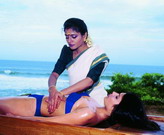
|
Abhyangam (or abhyanga) is an oil massage.
Massage is necessary to keep our bodies healthy and Ayurveda points out the benefits of daily massage:
1. Improved visual acuity
2. Prevents premature aging
3. Increased life expectancy
4. Soothes aches and relaxes, causing a feeling of well being
5. Beautifies the complexion and improves skin resistance
6. Good sleep
7. Improved metabolism, improved blood pressure
It is beneficial to have a full body massage every day, because it can stimulate many receptors, especially in the ears (Sravana), feet (Pada) and head (Sira), which were originally certain processes in our body.
Contra-indications :
1. in the case of Kapha dominant diseases
2. in people who have recently performed Vamana (therapeutic vomiting) and Virechna (purgation)
3. in people prone to indigestion
The term "massage" is used in English, but in fact, the abhyangam is not primarily intended to massage the muscles, but rather to penetrate into the body, and through the skin, oleaginous substances that will bring it the nutrients that are lacking (evaluated during the diagnosis established by the vaidya).
A "massage" with sesame oil, for example, without medical "piloting", will have a relaxing effect, but will not respond to the ayurveda charter and will have no controllable effects on health.
|
A
B
C
D
E
F
G
H
I
J
K
L
M
N
O
P
Q
R
S
T
U
V
W
X
Y
Z
A
B
C
D
E
F
G
H
I
J
K
L
M
N
O
P
Q
R
S
T
U
V
W
X
Y
Z
A
B
C
D
E
F
G
H
I
J
K
L
M
N
O
P
Q
R
S
T
U
V
W
X
Y
Z
A
B
C
D
E
F
G
H
I
J
K
L
M
N
O
P
Q
R
S
T
U
V
W
X
Y
Z
A
B
C
D
E
F
G
H
I
J
K
L
M
N
O
P
Q
R
S
T
U
V
W
X
Y
Z
A
B
C
D
E
F
G
H
I
J
K
L
M
N
O
P
Q
R
S
T
U
V
W
X
Y
Z
A
B
C
D
E
F
G
H
I
J
K
L
M
N
O
P
Q
R
S
T
U
V
W
X
Y
Z
A
B
C
D
E
F
G
H
I
J
K
L
M
N
O
P
Q
R
S
T
U
V
W
X
Y
Z
A
B
C
D
E
F
G
H
I
J
K
L
M
N
O
P
Q
R
S
T
U
V
W
X
Y
Z
A
B
C
D
E
F
G
H
I
J
K
L
M
N
O
P
Q
R
S
T
U
V
W
X
Y
Z
A
B
C
D
E
F
G
H
I
J
K
L
M
N
O
P
Q
R
S
T
U
V
W
X
Y
Z
A
B
C
D
E
F
G
H
I
J
K
L
M
N
O
P
Q
R
S
T
U
V
W
X
Y
Z
A
B
C
D
E
F
G
H
I
J
K
L
M
N
O
P
Q
R
S
T
U
V
W
X
Y
Z
A
B
C
D
E
F
G
H
I
J
K
L
M
N
O
P
Q
R
S
T
U
V
W
X
Y
Z
A
B
C
D
E
F
G
H
I
J
K
L
M
N
O
P
Q
R
S
T
U
V
W
X
Y
Z
A
B
C
D
E
F
G
H
I
J
K
L
M
N
O
P
Q
R
S
T
U
V
W
X
Y
Z
A
B
C
D
E
F
G
H
I
J
K
L
M
N
O
P
Q
R
S
T
U
V
W
X
Y
Z
A
B
C
D
E
F
G
H
I
J
K
L
M
N
O
P
Q
R
S
T
U
V
W
X
Y
Z
A
B
C
D
E
F
G
H
I
J
K
L
M
N
O
P
Q
R
S
T
U
V
W
X
Y
Z
A
B
C
D
E
F
G
H
I
J
K
L
M
N
O
P
Q
R
S
T
U
V
W
X
Y
Z
A
B
C
D
E
F
G
H
I
J
K
L
M
N
O
P
Q
R
S
T
U
V
W
X
Y
Z
A
B
C
D
E
F
G
H
I
J
K
L
M
N
O
P
Q
R
S
T
U
V
W
X
Y
Z
A
B
C
D
E
F
G
|
|
8 BRANCHES OF AYURVEDA |
Kaya Chikitsa : General Medicine
Bala Chikitsa : Obstetrics, Gynecologiy Pediatry
Graha Chikitsa : Psychiatry et demonology
Shalakya Tantra : ENT and Ophthalmology
Shalya Tantra : Surgery
Agada Tantra / Visha Chikitsa : Toxicology
Jara / Rasayana Tantra : Geriatrics
Vajikarana : Sexology
|
|
CHOORNASWEDAN
|
This treatment begins with an application Dosha specific oil all over his body. The whole body is then forced to eliminate deeply after a thorough massage with herbal powder placed in a cloth. It relieves nervous disorders, rheumatism, arthritis and sports injuries.
|
|
CHOORNA ABHYANGAM
|
Massage with powder
In this massage, the therapist applies special herbal powders to the body for 45 minutes. This massage is very effective against obesity, hemiplegia, certain paralysis, circulatory disorders, etc ...
|
|
CLEANSING
|
|
|
DETOXIFICATION
|
We call detoxification the process of elimination, disposal or processing of toxins in the body, as well as the elimination of mucus and congestion. Some of these toxins such as pesticides, heavy metals, etc.. come from our diet, drug use, exposure to the environment, etc...
|
|
DHARA
|
Herbal oils, a decoction of herb milk or ghee are poured continuously on the forehead or on the body. Several variants have different targets, as Oordhwanga Dhara, good for diseases of the eyes, ears and skin, Tikrit Dhara (for those who suffer from memory loss, migraines, or psychiatric disorders), Sarvanga Dhara (for head and body) and Siro Dhara (stress and imsomnies).
|
|
DHARA POT
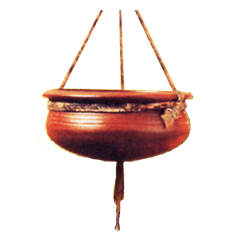
|
Récipient suspendu utilisé pour faire les dharas, notamment shirodhara.
|
|
DOSHAS
|
The human body is composed of five elements:
- Ether (corresponding to the formless, invisible, penetrating)
- Air (lightness, dryness, mobility, cold, roughness, smoothness, subtlety, clarity)
- Fire (heat, spice, clarity, subtlety)
- Water (moisture, smooth, cold, stable, soft, fat, smooth)
- Earth (heaviness, weight, strength, cold, static, slowly, firmness, roughness)
manifested in human physiology in the form of three doshas (biological humors or biometabolical principles):
- Vatha (Ether + Air) on traffic, transit and communication, and represents all macrochannels and all the microchannels (nervous system, circulatory system, etc..), The energy flows in motion. We may associate the movement of Vatha to Brahma and to Sattva guna.
- Pitta (fire + water) affects the tranformation or metabolism. It represents the enzymes and hormones, digestion. We may associate the regenerative and transforming capacities of Pitta to Shiva, and to Rajas guna.
- Kapha (earth + water) covers all structures and represents the organic tissues (bone, muscle, nerve tissue, adipose tissue, etc.). It may evoque the stabilizer ability of Vishnu and of Tamas gunas.
These three doshas or forces underlying the functioning of various body systems. An imbalance of doshas leads to a state of disease.
Summary table of characteristics of the three doshas:
|
Vata
|
Pitha
|
Kapha
|
|
Dry
|
Greasy
|
Greasy
|
|
Cold
|
Hot
|
Cold
|
|
Light
|
Light
|
Heavy
|
|
Irregular
|
Fluid
|
Stable
|
|
Mobile
|
Flabby
|
Viscous
|
|
Choppy
|
Malodorousy
|
Dense, sweet
|
To determine what is your tridosha profile, follow the link:
AYURVEDA - TEST
|
|
DHRONI
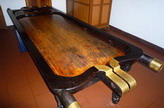
|
The Dhroni is a special massage table that can make care-based oils. It is slightly hollowed to collect them after use.
|
|
ELAKIZHI
|
"Ela" means "leaves" and "kizhi" means "tempon"
Plant leaves and powders are packaged in small cotton bags placed on the parts to be treated, after they have been dipped in warm medicinal oils. This is done for 20 minutes. This is very effective for osteoarthritis, spondylosis, sports injuries, stiff joints and muscles, etc.
Testimonial: it is quite surprising as an effect, especially the noise, a bit like a machine gun because it is practiced by several people. But to penetrate the active ingredients, it is very effective.
|
|
GHEE (GHI) |
The ghi is prepared by simmering unsalted butter in a large pot until all the water has evaporated and the protein has sedimented to the bottom. The clarified butter is then removed with a spoon to avoid remixing the solid particles with the clarified butter. Unlike butter, ghi can be stored for long periods without refrigeration as long as it is stored in a sealed container to prevent oxidation and mold. The texture, color and taste of the ghi depends on the source of the milk from
which the butter was obtained and the duration of the boiling. In India, ghi is usually obtained from water buffalo milk.
Absorption: Ghi is an essential part of herbal Ayurveda formulations. As ghi is a butter, it can bind with the nutrients soluble in lipids and herbs to penetrate the plasma membranes of the body's cells. It can be added that it increases the potential of certain herbs by transporting the active components inside the cells where they have the maximum effect.
Digestion: Ayurveda texts say that ghi helps reduce excess stomach acid and helps restore or maintain mucus in the stomach.
Light burns: Like aloe, ghi helps prevent blisters and lesions if applied quickly to the skin. The long stored ghi would have superior medicinal properties.
|
|
FOOT MASSAGE |
Specialty of Kerala, very practiced in kalaripayat.
It is not recommended for people with vertebral disorders.
It is also called PADABHYANGAM, or CHAVUTTIUZHICHIL or CHAVITTITHIRUMAL
|
|
HEAD MASSAGE
|
Shiro abhyangam
|
|
HERBAL STEAMBATH
|
Sauna
|
|
HUILES DE MASSAGE |
Plants massage oils
There are, in fact, more than a thousand formulations of massage oils, in Ayurveda, but we will retain mainly 16 for women, 14 for men, for the most common indications:
- * Aloe: hair oils to give color to the hair and stimulate their growth.
- * Aparajita: the seeds give an oil that is used to leave the phlegm in case of chronic bronchitis.
- * Arka: provides relief for joint pain, tumors, rheumatic pain and skin problems.
- * Asparagus: The oils of this climbing plant cure rheumatism, joint diseases, stiff neck, hemiplegia and other diseases of the nervous system.
- * Basil: the paste is applied locally in case of skin diseases.
- * Turmeric: paste to apply on sprains, wounds, eczema and inflamed joints.
- * Indian beech: massage oils to heal scabies, wounds, herpes and eczema.
- * Hibiscus: hair oil used to stimulate hair growth.
- * Indian Hydrocotyle: cures psoriasis, abscesses and chronic rheumatism.
- * Margosa: against eczema, ringworm and scabies.
- * Muringa: against inflammations, gout and acute rheumatism.
- * Myrobolan Arjuna: used to cure acne.
- * Malabar walnut: the leaves are used, in the form of macerated oil, for the massage of rheumatoid arthritis and inflammations.
- * Castor: extracted from seeds, castor oil is indicated to treat lumbago, sciatica, rheumatic inflammations and gout.
|
|
ILAKIZHI
(ELAKIZHI) |
Plant leaves and powders are packaged in small cotton bags placed on the parts to be treated, after they have been dipped in warm medicinal oils. This is done for 20 minutes. This is very effective for osteoarthritis, spondylosis, sports injuries, stiff joints and muscles, etc.
|
|
KANSU BOWL
|
Foot massage with KANSU bowls is a traditional practice of Gujarath, and is not strictly Ayurvedic, but as the word is used extensively, it gives it an apparent legitimacy ...
It is also called KANSA VATAKI. Its appearance in the West seems to have started in France in the 1990s.
E-mail Exchange - January 2013 - with Dr. Ajumal, owner of Punarnava Hospitals in Cochin and Kerala:
Dear Dr. Ajumal,
I have here in FRANCE people who perform the KANSU bowl massage.
They say it is an ayurvedic old treatment, a foot massage with 3 bowls in different metals, and ghee. I had never heard about it. Could you tell me if you use it in genuine Ayurveda? It might be fake?
Warm regards,
GB
Reply :
No. It has not been mentioned or practiced anywhere in Ayurveda.
Dr. Ajumal
|
|
KAPHA
|
Kapha (earth + water), concerns all structures and represents the organic tissues (bone, muscle tissue, nervous tissue, adipose tissue, body stability, flexibility, joints, patience, etc.).
Kapha's heavy capacity can be combined with Shiva (Rudra) and Tamas guna.
|
|
KARNADHOOPANAM
|
Antiseptic fumes with essences are blown into the ears for 5 to 10 minutes. This process helps cleanse and purify the ears
|
|
KARNAPOORAM
|
Treatment for affections of the ears. Medicinal oils are poured into the ear for 5 to 10 minutes a day, both to cleanse and to treat the different conditions.
|
|
KATIVASTHI/KADEEVASTHI
 VIDEO
VIDEO
|
Kathi means "lower back" and vasthi means pool in English, a small liquid surface.
Warm oil is trapped in a small barrage of herbal paste, all placed on the lower back for a good half hour (up to 45 minutes or even an hour).
It is excellent for all back pain, and mainly lumbar.
This may result in a drop in Momentary energy after this treatment.
|
|
KAYAKALPA CHIKITSA
|
Flagship treatment for delaying aging, it stops cell degeneration and auto-immunization.
Includes Rasayana Absorption (Ayurvedic medications accompanied by a specific diet) and a particular body care program.
|
|
KIZHI
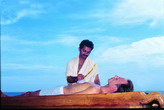
|
Kizhi is a care where heated herbs and oils are packaged in small cotton bags placed on the parts to be treated.
This treatment is followed by specific massages, done using the fingers, the palm of the hand or the wrist. The applied pressure varies according to the nature of the affection and its location.
Kizhi is pronounced "Kiri" in Kerala.
Duration of treatment: 45 minutes daily for 7 to 14 days.
Recommended for people who suffer from arthritis with swelling, sports injuries, etc ...
|
|
KOLTHIRUMMU
|
Massage using rounded wooden medicinal sticks
|
|
LEPAM / LEPANAM
 VIDEO
VIDEO
|
Many varieties of herbs are used to coat the body and face after massage, and dry it.
These herbs behave like brushes as well as toners and help the skin regenerate by making it blush.
Skin problems; gout, arthritis.
|
|
LUNGOTI

|
Cotton fabric that is tied around the waist to serve as a male suspender during body massage.
More and more replaced by disposable briefs in non-woven, with elastic in the seams.
|
|
MALAS |
Unnecessary residues that clog our cells or our koshas.
|
|
MARMA
|
According to practitioners of some martial arts in Kerala in southern India, such as Kalarippayatt or Varma Kalai, marmas are the 107 vital points of the human body. Proponents of these techniques claim to be able to neutralize or kill an opponent by exerting pressure or shock on some of these points. Some branches of traditional Indian medicine, Ayurveda, also claim to stimulate or massage these points in order to achieve a therapeutic effect.
One of the earliest evidence of these points goes back to the Rig-Veda, where it says that Indra managed to defeat Vritra by attacking his vital points with his vajra. But it was the Sushruta (5th century BC) chirgurgian who first described these 107 vital points in his Sushruta Samhita. Of these 107 points, 64 were defined as potentially lethal if properly punched or slashed.
Marmas can be arranged in six categories according to their location in the body:
* Mamsa Marma (on the skin / muscles)
* Asthi Marma (on the bones)
* Snayu Marma (on the tendons)
* Dhamani Marma (on the nerves)
* Sandhi Marma (on the joints)
* Sira Marma (on the veins)
|
|
MASSAGE |
The term "massage" is to be considered - concerning ayurveda - in a different way than what we know, because the abhyangam, for example, is not primarily intended to massage the muscles, but rather to make penetrate into the body, and through the skin, oleaginous substances that will provide it with the nutrients that are lacking (evaluated during the diagnosis established by the vaidya) or substances of which reaction will prepare the ground for the panchakarma.
The movement of the hands may be circular or linear, but the primary purpose will be the penetration of the oils.
An Indian "massage" with sesame oil, for example, without control by a vaidya, may have a relaxing effect, but will not meet the Ayurveda charter and will have no controllable effects on health.
The term "Ayurvedic massage" often describes all Ayurvedic treatments, even if there is no proper massage.
|
|
MUKHALEPAM |
Facial treatment with different kinds of herbal creams. Very effective to get rid of wrinkles, cellulite, blackheads. This treatment beautifies and rejuvenates the skin of the face.
|
|
NADIS |
Subtle energy channels. Polarized ida and pingala. They roll in a double helix along the sushrumna and cross each chakra.
|
|
NASYAM
 VIDEO
VIDEO
|
Part Panchakarma
Oil is poured into the nostrils, chosen according to the disorders taken into consideration.
Recommended in case of headaches, dental pains, paralysis, skin diseases, etc ...
Duration of treatment: 7 to 14 days.
|
|
NAVARAKIZHI
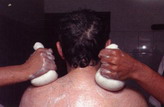
 VIDEO
VIDEO
|
Treatment against muscle degeneration, rheumatism, sports injuries, joint pain, emaciation of certain parts of the body and certain skin diseases.
The whole body is buffered by small bags of soaked rice to sweat and receive the essences.
|
|
NELLIKA THALAM
 VIDEO
VIDEO
|
Nellika thalam is a variant of Thalam, particularly recommended for psychic disorders.
Nellika means gooseberry, and thalam head, skull.
See THALAM
|
|
NETHRA DHARA
 VIDEO
VIDEO
|
|
|
PADABHYANGAM
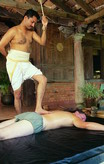
|
Uzhichil massage with feet, also applied CHAVUTTIUZHICHIL or CHAVITTITHIRUMAL
The therapist uses his hands and feet to massage.
This Kerala full body massage is great for general relaxation, increasing flexibility, reaching deep muscles and stimulating blood circulation.
It is not recommended for people with vertebral and articulatory disorders.
|
| PANCHAKARMA
|
Panchakarma
The term PANCHAKARMA has become a generic term for detoxification cures -rejuvenation, but the integral panchakarma (which takes at least three weeks) is scalable depending on the patient's state of health. and serves as a base for subsequent treatments.
The Sodhana treatment for eliminating diseased doshas is also called Panchakarma (Pancha = five and karma = steps, systems).
These five steps are:
1. Vamana, therapeutic vomiting (little used)
2. Virechna, purgation
3. Nasya, elimination of toxins through the nose
4. Sneha Vasthi, rectal enema with oils
5. Kashaya Vasthi, enema made from plant decoction
To learn more, follow this link PANCHAKARMA
Panchakarma est précédé par Purvakarma et suivi par Pasthakarma |
|
PICHU
 VIDEO
VIDEO
|
A cloth soaked in hot oils is pressed on the diseased parts.
It may concern :
paralysis, rheumatism, psychosomatic symptoms.
|
| PITTA
|
* Pitta (fire + water), concerns the transformation or metabolism. It represents enzymes and hormones, digestion.
One can associate the energy and luminous capacity of Pitta with Brahma, and the guna Rajas.
Responsible for the following organic functions:
* Pitta is responsible for appetite, body temperature, eyesight, digestion, smell, taste, shine, intelligence, energy and flexibility from the body.
|
|
PIZHICHIL
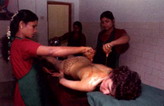
 VIDEO
VIDEO
|
Pizhichil is also called Sarvangdhara: a dhara (see the word) is applied all over the body.
This treatment is a wonderful combination of two very classic Ayurvedic treatments: Snehana (oil anointing) and Swedana (sweating)
Warm oil is poured on the body by spinning cloths regularly soaked in a cauldron.
Pizhichil is a very effective remedy for achieving total relaxation. This treatment is also very useful for sexual weakness, nervous fatigue, Vata imbalances,
hypertension and weight loss of the limbs.
Testimonial: it is in any case a unique experience, because we bathe in the fat. We slide from right to left in the dhroni as if we were on an ice rink. Needless to say, the only garment after that is the special bathrobe you've been given, even if you're scraped from top to bottom with a folded banana leaf.
|
| PURVAKARMA
|
Purvakarma prepares the body for Panchakarma and is the first cleansing treatment offered to almost all patients.
Purvakarma has two forms:
* the oil massage (snehana karma)
* sweating (swedana karma)
Purvakarma is followed by Sanodhnakarma (panchakarma) himself followed by pasthakarma
|
|
POUCH MASSAGES
|
Stamp with small bags (pouches) all over the body (for kizhi)
|
|
PRAKRUTI
|
|
|
RASAYANA CHIKITSA
|
Rejuvenation care (rejuneve massage) (chikitsa = therapy)
Tones the skin and rejuvenates and strengthens all tissues to ensure a balanced and lasting health.
Optimizes Ojas (elemental vitality) as well as Sattva (clarity of mind), which has the effect of improving the resistance of the whole human body.
Treatment includes face and head massage with macerated oils and balms, body massages with either oils or powders, with hands or feet, regenerative pills and saturated steam baths of appropriate macerated oils. Herbal baths (macerated hules) are also used.
|
|
REJUVENATION MASSAGE
|
Rejuvenation, r (see rasayana chikitsa)
|
|
SHIRODHARA
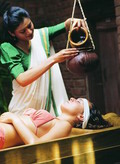
 VIDEO
VIDEO
|
Siro (or shiro) means head (shiras in Malayalam) and Dhara is a continuous flow of any liquid: Sirodhara is an unforgettable experience. (see Dhara)
Flowing warm oil on the forehead and head with wave movements reduces stress, insomnia, hyperactivity, irritability, hair problems and all the disorders caused by Vata.
Against indication: sinusitis and fever.
There are two other names for this dhara that come from the nature of the product flowing on the head
* ksheeradhara (here it is not oil, but medicated milk)
* takradhara (here it is not oil, but medicated butter)
two other forms also exist: tailadhara and jaladhara
The choice of liquid depends on the conditions concerned.
Testimony: hovering! Risk of falling asleep guaranteed, even for insomniacs.
|
| SIROPICHU
|
It's a Pichu of the head. (siras, siro = head)
Recommended for hair loss, loss of vision, stress, etc.
|
|
SIROVASTHI
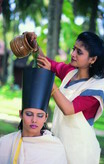
 VIDEO
VIDEO
|
Warm oil is poured into a kind of top hat fitted to the skull.
The treatment lasts about an hour and is repeated daily for seven days.
It is a traditional method to fight head diseases and facial paralysis.
Especially effective for people who suffer from facial paralysis, dry nostrils, mouth and throat. Neck and head pain.
|
| SNEHANA
|
This technique involves penetrating the oils by massaging the body to promote the elimination of toxins. Oil mixtures are used to treat specific disorders (stress, anxiety, insomnia, arthritis, circulatory problems, etc ...) Massaging the scalp helps treat depression, insomnia and poor memory.
|
| SNEHAPANAM
|
Sneha means "oil" and panam means "drink". In fact it is ghee (clarified butter) that is used.
This treatment is an essential passage in cellular detoxification, and is not always fully realized in Ayurvedic resorts given the inconvenience it causes, however it is really very effective.
In Ayurvedic hospitals it lasts between 3 and 5 days, depending on the predominant dosha. On the first day 60 ml of ghee are absorbed, the second 120, the third 240, the fourth 120 and the fifth 60.
This has the effect of saturating the cells which reject by reaction the excess of ghee in which then are stuck toxins. The cells stripped of these toxins become thinner, and a space is created between each cell, allowing the rejected and "charged" ghee to be eliminated.
The nucleus of the cell is attached to vatha, the interior to pitha and the envelope to kapha. The expulsion of toxins by osmosis restores the primordial balance of the three doshas in the cell itself.
|
| SPA
|
In the twentieth century, the name "Spa" became gradually and internationally a common masculine name with different meanings. It refers generically to a spa, mineral water, a hot tub, a fitness center or it is a particular obstacle equestrian.
Among the different hypotheses about the etymological origin of Spa, we will remember that of "springing source" of the Latin sparsa "scattered" and "spurting" past participle spargere, or, more simply, "free space" Walloon spâ and the Latin Spatia, plural Spatium. It was three centuries later (XVII) that he crossed the Channel to become gradually "spa" in the English language. Three centuries later (twentieth century), it becomes world
"hot tub" or "fitness center".
It is remembered that William Slingsby, who had stayed at Spa, discovered in 1571 a spring in Yorkshire which he called Harrogate. Dr. Timothy Bright called him in 1596, "The English Spaw", from which the generic term "spa" seems to come.
One generalization of a belief (conveyed willingly by the institutions themselves) that SPA would be an ancient Roman acronym meaning "Sana Per Aqua" or "Sanitas Per Aquam" or "Senare Per Aqua". It is a retro acronym, a posteriori manufacture of a fictitious acronym
SPA Ayurveda are actually fitness centers where we introduced some practices from Ayurvedic medicine. The use of the two words together, paradoxical when one knows ayurveda, exploits one of the subsequent qualities of ayurveda: to bring well-being.
|
| SROTAS |
There are 16, according to Charaka Samhita, invisible channels in which circulate essential elements of the tissues, doshas and malas (to meridians closer to Chinese acupuncture).
|
| STRESS RELIEF
| |
|
SWEDA KARMA
|
Sweda = sweating.
Vapor baths with essential oils easily remove impurities from the skin, improve its tone and appearance, lose weight and are recommended for certain rheumatic cases, especially in case of severe pain.
Rare herbs and medicinal leaves are boiled and the steam that emanates is passed over the entire body for 10 to 20 minutes every day.
Manual massage with medical oils and powders improves circulation and tones muscles.
|
| TAKRADHARA
|
Takra means liquid butter (buttermilk) and Dhara means payment. This care is different from Sirodhara. The butter is slowly poured on the forehead to relieve insomnia, depression and other stress-related problems. It protects against hair whitening, reduces the frequency of migraines, increases digestive capacity and reduces anorexia while relieving. In cases of psoriasis, Dhara is used on specific places to enhance the effect.
|
|
THALA POTHICHIL
 VIDEO
VIDEO
| Thala = head, pothichil = cover.
|
|
THALAM
 VIDEO
VIDEO
|
Recommended for throat problems, ears, migraine, hair loss and dandruff. (NB thala = head, skull)
In this treatment a specific powder is mixed with oils to make a paste, and is applied on the upper part of the head where it must remain between 20 and 45 minutes depending on the case. Sometimes this paste is maintained by a vegetable leaf.
|
|
THARPANAM
|
Treatments to clean the eyes and guard against infections.
Ghee is kept on the eyes
|
|
THERAPIST
|
We often call them "masseurs", but they are far more than that. There is a large vaiety of treatments which need specific skills
|
|
THIRUMMAL
|
THIRUMMAL means intensive massage and is practiced by two therapists. (same as uzhichil, but done with 4 hands)
This regenerating massage improves the circulation of energies in the body. The aim of the thirminal bur is to grease the body externally in order to favor its texfication. The massage strengthens the tissues and the biological fire and improves longevity.
It is particularly recommended for disorders of the nervous system.
The treatment begins with a head massage, the patient sitting on a chair, then continues with a massage on the table of the whole body, punctuated with 4 hands, all with the appropriate oils.
|
|
UDWARTHANAM
 VIDEO
VIDEO
|
Dry massage with warm powders according to a traditional method for 30 to 45 minutes. It is effective for reducing weight, restoring strength and stability, giving a better appearance of the skin and for clinical conditions where Kapha predominates (see Dosha)
|
|
UZHICHIL

 VIDEO
VIDEO
|
Uzhichil is a type of oil massage that regenerates the nervous and muscular systems and improves blood circulation. This massage is done by applying medical oils all over the body and gently massaging with the feet and hands according to the rules of Ayurvedic medicine.
So there are mainly two kinds of Uzhichil massages:
* Kaiuzhichil, made with the hands
* Chavuttiuzhichil, done with the feet.
The massage with the feet being more tonic, it is rather indicated to the young people or in good health.
Kaiuzhichil: the treatment starts with a head massage, then a total massage on the table with the appropriate oils.
|
|
VAIDYA
|
Ayurvedic doctor. He's been called "Doctor".
The study of Ayurvedic medicine lasts 11 semesters and is sanctioned by a diploma (BAMS = Bachelor of Ayurveda Medicine and Surgery). The course is completed after two years of internship followed by two years of specialization and two years of practice under the supervision of an experienced doctor.
|
|
VATHA
|
Vatha (ether + air), concerns the circulation, the transit and the communication and represents all the macrochannels and all the microchannels (nervous system, circulatory system, etc.), the energetic flows in movement.
We can associate the lightness of movement of Vatha with that of Vishnu and the guna Sattva.
Vatha is responsible for the following organic functions:
breathing (inspiration and exhalation), body movements, elimination of organic waste, correct transformation of dathus (namely Rasaà Rakthaà Mamsaà Medhusà Asthià Majjaà Sukra and finally Ojus, the final product of dathus) and proper functioning of sensory perceptions.
|
|
WEIGHT CONTROL
|
|
|
WELL-BEING - WELLNESS
|
Well-being (this is not the goal of true Ayurveda ... although this assertion may hinder an image that would like to support the "well-being" professionals in search of new products.)
Ayurveda is a medicine whose primary motivation is the maintenance of physical and mental health associated to a practical awareness of the interdependance between what you are and the whole world around you. Upstream of the medical aspect, there is the notion of being "well", all right, balanced, but the term Being has not the same value as that associated with well-being, and the homonymy can be confusing ...
|
|
